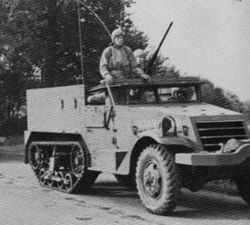 W
WThe M2 half-track car is an armored half-track produced by the United States during World War II. Its design drew upon half-tracks imported from France in the 1930s, employing standard components supplied by U.S. truck manufacturers to speed production and reduce costs. The concept was designed, and the pilot models manufactured by the Firestone Tire and Rubber Company Production by the White Motor Company began in 1940 and was expanded to include Autocar.
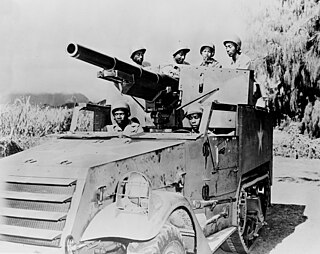 W
WThe M3 Gun Motor Carriage (GMC) was a United States Army tank destroyer equipped with a 75 mm M1897A4 gun, which was built by the Autocar Company during World War II.
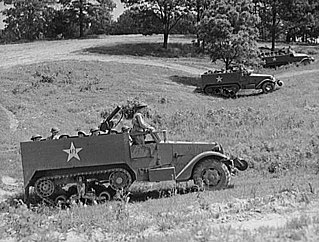 W
WThe M3 half-track was an American armored personnel carrier half-track widely used by the Allies during World War II and in the Cold War. Derived from the M2 half-track car, the M3 was extensively produced, with about 15,000 standard M3s and more than 38,000 variant units manufactured.
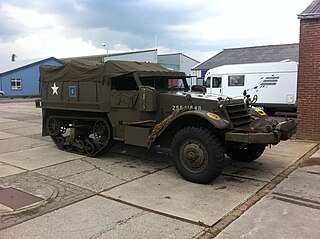 W
WThe M5 half-track was an American armored personnel carrier in use during World War II. It was developed in 1942 when existing manufacturers of the M2 half-track car, and M3 half-track could not keep up with production demand. International Harvester (IH) had capacity to produce a similar vehicle to the M3, but some differences from the M3 had to be accepted due to different production equipment. IH produced the M5 from December 1942 to October 1943.
 W
WThe M9 half-track was a half-track produced by International Harvester in the United States during World War II for lend-lease supply to the Allies. It was designed to provide a similar vehicle to the M2 half-track car. It had the same body and chassis as the M5 half-track but had the same stowage and radio fit as the M2 half-track.
 W
WThe M13 Multiple Gun Motor Carriage (MGMC), otherwise known as the M13 half-track, was a self-propelled anti-aircraft gun used by the U.S. Army during World War II that was armed with two .50 caliber M2HB heavy-barrel Browning machine guns. Developed in response to a requirement for a mobile anti-aircraft (AA) vehicle, the vehicle was produced by the White Motor Company between July 1942 and May 1943. The only time it was ever used in combat was when the Americans landed at Anzio in January 1944. It was replaced by the more heavily armed M16 Multiple Gun Motor Carriage in April 1944.
 W
WThe M15 half-track, officially designated M15 Combination Gun Motor Carriage, was a self-propelled anti-aircraft gun on a half-track chassis used by the United States Army during World War II. It was equipped with one M1 automatic 37 millimeter (1.5 in) gun and two water-cooled .50 caliber (12.7 mm) M2 Browning heavy machine guns. Based on the M3 half-track chassis, it was produced by the White Motor Company and Autocar between July 1942 and February 1944, and served alongside the M16 Multiple Gun Motor Carriage.
 W
WThe M16 Multiple Gun Motor Carriage, also known as the M16 half-track, was an American self-propelled anti-aircraft weapon built during World War II. It was equipped with four .50 caliber (12.7 mm) M2 Browning machine guns in an M45 Quadmount. 2700 were produced by White Motor Company from May 1943 to March 1944, with 568 M13 MGMCs and 109 T10 half-tracks being converted into M16s as well.
 W
WThe M21 Mortar Motor Carriage (MMC) was a self-propelled artillery mount on a half-track chassis used by the United States Army during World War II. It was equipped with an 81 mm M1 mortar and an air-cooled M2 Browning machine gun. It was produced by the White Motor Company in 1944. Only 110 examples were produced.
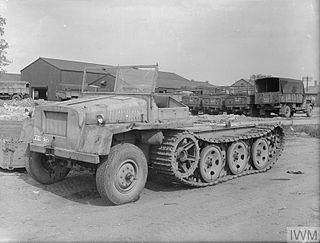 W
WThe Schwerer Wehrmachtschlepper was a German World War II half-track vehicle used in various roles between 1943 and 1945. The unarmored models were used as supply vehicles and as tractors to haul artillery. Armored versions mounted anti-aircraft guns or a 10 barrel rocket launcher (Nebelwerfer). Fewer than a thousand were built before the end of the war, but production continued after the war of an improved model in the Tatra plant in Czechoslovakia.
 W
WThe Sd.Kfz.2 is a half-track motorcycle with a single front wheel, better known as the Kleines Kettenkraftrad HK 101 or Kettenkrad for short.
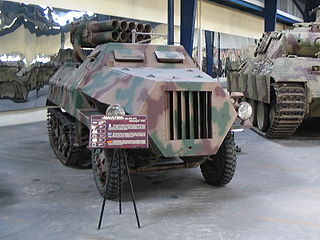 W
WThe Sd.Kfz. 4 Gleisketten-Lastkraftwagen, was a 4.5-tonne military truck of Maultier ("mule") half-track family developed during World War II by Germany. Its manufacturer designation was Mercedes-Benz L4500R.
 W
WThe Sd.Kfz. 6 was a half-track military vehicle used by the German Wehrmacht during the Second World War. It was designed to be used as the main towing vehicle for the 10.5 cm leFH 18 howitzer.
 W
WThe Sd.Kfz. 7 was a half-track military vehicle used by the German Wehrmacht Heer, Luftwaffe and Waffen-SS during the Second World War. Sd.Kfz. is an abbreviation of the German word Sonderkraftfahrzeug, "special purpose vehicle". A longer designation is Sd.Kfz. 7 mittlerer Zugkraftwagen 8t, "medium towing motor vehicle 8t".
 W
WThe Sonderkraftfahrzeug 8, usually abbreviated to Sd.Kfz. 8, was a German half-track designed by Daimler-Benz that saw widespread use in World War II. Its main roles were as a prime mover for heavy towed guns such as the 21 cm Mörser 18, the 15 cm Kanone 18 and the 10.5 cm FlaK 38, however it was also capable of serving as an infantry transport. Approximately 4,000 were produced between 1938 and 1945. It was used in every campaign fought by the Germans in World War II, notably the Invasion of Poland, the Battle of France, the Balkans Campaign, the Eastern Front, the North African Campaign, the Battle of Normandy and the Italian Campaign.
 W
WThe Sd.Kfz. 9 was a German half-track that saw widespread use in World War II, and the heaviest half-track vehicle of any type built in quantity in Nazi Germany during the war years. Its main roles were as a prime mover for very heavy towed guns such as the 24 cm Kanone 3 and as a tank recovery vehicle. Approximately 2,500 were produced between 1938 and 1945.
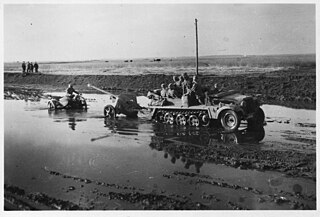 W
WThe Sd.Kfz. 10 was a German half-track that saw widespread use in World War II. Its main role was as a prime mover for small towed guns, such as the 2 cm Flak 30, the 7.5 cm leIG, or the 3.7 cm Pak 36 anti-tank gun. It could carry eight troops in addition to towing a gun or trailer.
 W
WThe Sd.Kfz. 11 was a German half-track that saw widespread use in World War II. Its main role was as a prime mover for medium towed guns ranging from the 3.7 cm FlaK 43 anti-aircraft gun up to the 10.5 cm leFH 18 field howitzer. It could carry eight troops in addition to towing a gun or trailer.
 W
WThe Sd.Kfz. 250 was a light armoured half-track, very similar in appearance to the larger Hanomag-designed Sd.Kfz. 251, and built by the DEMAG firm, for use by Nazi Germany in World War II. Most variants were open-topped and had a single access door in the rear.
 W
WThe Sd.Kfz. 251 half-track was a World War II German armored personnel carrier designed by the Hanomag company, based on its earlier, unarmored Sd.Kfz. 11 vehicle. The Sd.Kfz. 251 was designed to transport the Panzergrenadier into battle. Sd.Kfz. 251s were the most widely produced German half-tracks of the war, with at least 15,252 vehicles and variants produced by seven manufacturers. Some sources state that the Sd.Kfz. 251 was commonly referred to simply as "Hanomags" by both German and Allied soldiers after the manufacturer of the vehicle; this has been questioned, and may have been only a postwar label. German officers referred to them as SPW in their daily orders and memoirs.
 W
WThe leichter gepanzerter Munitionstransportwagen was a light armoured ammunition carrier used by Nazi Germany during World War II as early as the Battle of France in June 1940.
 W
WSd.Kfz. 253 leichter Gepanzerter Beobachtungskraftwagen was a German half-track observation vehicle that was used by artillery forward observers to accompany tank and mechanized infantry units. The vehicle belonged to the Sd.Kfz. 250 family. The appearance was similar to the Sd.Kfz. 250, but the Sd.Kfz. 253 variant was fully enclosed. Demag/Wegman manufactured 285 vehicles between 1940–1941.
 W
WThe SOMUA MCG was a half-track artillery tractor and recovery vehicle of the French forces during World War II.
 W
WThe T19 Howitzer Motor Carriage (HMC) was a 105 mm (4.1 in) howitzer mounted on a M3 Half-track chassis. It saw service during World War II with the U.S. Army. Its secondary armament consisted of an air-cooled .50 in (13 mm) M2 machine gun for local defense. It was produced by Diamond T between January 1942 and April 1942.
 W
WThe T30 Howitzer Motor Carriage (HMC) was a United States Army self-propelled gun used in World War II. Its design was based on requirements for an assault gun issued by the Armored Force in 1941 and it was built as an interim solution until a fully tracked design was complete.
 W
WThe T48 57 mm Gun Motor Carriage was a self-propelled anti-tank gun produced by the Diamond T company in 1943 for the United States. The design incorporated a 57 mm gun M1, a US production of the British Ordnance QF 6 pounder, mounted on an M3 Half-track.
 W
WThe Type 1 Ho-Ha was a half-track armoured personnel carrier (APC) used in limited numbers by the Imperial Japanese Army (IJA) during World War II.